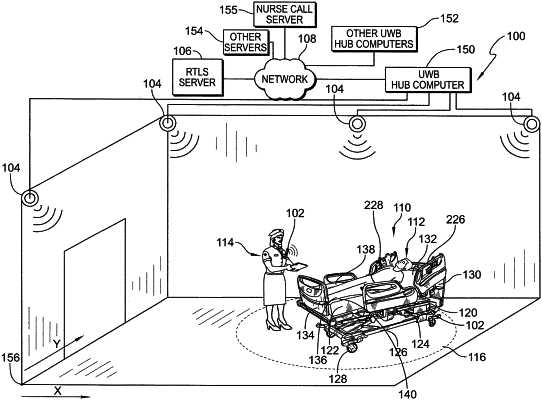| CPC G16H 40/20 (2018.01) [A61G 7/0527 (2016.11); G06K 7/10306 (2013.01); G16H 40/67 (2018.01); H04B 17/318 (2015.01); H04W 4/029 (2018.02); A61G 2205/60 (2013.01)] | 31 Claims |

|
1. A caregiver rounding system comprising
a bed configured to support a patient thereon, the bed including bed circuitry, a power cord, and casters,
an equipment locating tag coupled to the bed and in communication with the bed circuitry,
a caregiver locating tag coupled to a caregiver,
a plurality of receivers mounted at fixed locations and in wireless communication with the equipment locating tag and the caregiver locating tag,
at least one computer communicatively coupled to the plurality of receivers, wherein the equipment locating tag, the caregiver locating tag, the plurality of receivers, and the at least one computer cooperate to form a high-accuracy locating system operable to determine a location of the equipment locating tag and the caregiver locating tag within at least one foot of an actual location of the equipment locating tag and the caregiver locating tag, respectively, wherein the at least one computer models a rounding zone adjacent the bed based on the location of the equipment locating tag, wherein the at least one computer determines that the caregiver has successfully completed a caregiver round if the caregiver locating tag is located within the rounding zone for a threshold period of time,
wherein the equipment locating tag changes its role from operating as an equipment locating tag to operating as an additional receiver of the plurality of receivers after determining that the bed has become stationary based on a signal from the bed circuitry indicating the occurrence of at least one or both of the following: (i) the power cord of the bed being plugged into a power outlet, and (ii) the casters of the patient bed being braked.
|